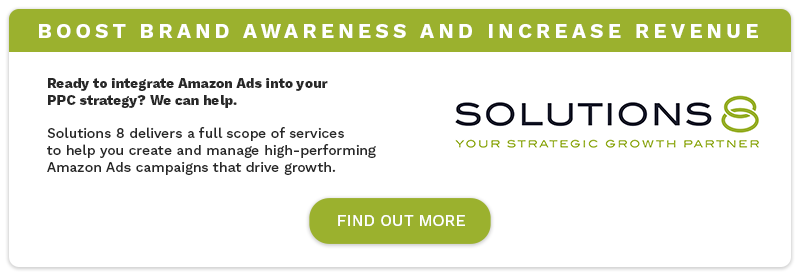
Are you thinking about adding Amazon Ads to your paid traffic strategy?
Launched in 1994 as an online bookstore, Amazon is now the most profitable online shopping site in the world, featuring more than 12 million different products and services.
In 2012, the company broadened their offering by adding new tools and services for Amazon vendors. This included a pay-per-click (PPC) advertising platform that would allow sellers to increase visibility and brand awareness by featuring ads about their products.
Since then, the platform has expanded in scope and services to become what we now know as Amazon Ads. Today, more than 300 million business owners advertise with Amazon, leveraging the enormous reach of the multinational tech company and the trust and recognition associated with the Amazon name.
Fun fact: Even businesses that do not sell products and services on Amazon can use the Amazon Ads platform (more on that below).
PPC Advertising: A Quick Refresher
Pay-per-click advertising (also known as cost-per-click, PPC, paid advertising) is exactly what it sounds like: Advertisers pay a set amount each time a user clicks on their ad.
In a nutshell, the advertiser will bid on a specific keyword or phrase, and the amount they have to pay is determined by several factors, including the bid amount, the quality of the ad, and the competition for that specific keyword or phrase.
PPC works in tandem with your other marketing channels to effectively drive traffic, help you reach more potential customers, and increase brand recognition.

How Does Amazon Advertising Work?
Like Google Ads or Meta Ads, Amazon Ads is a paid traffic platform that uses an auction-based bidding system wherein advertisers bid on specific keywords (which they hope will match user search queries) and pay a certain amount when shoppers click on their ads.
When advertisers set their bid, they are essentially letting the system know that is the maximum amount of money they are willing to pay for a click. Auctions happen in real time every time a user types a query into the Amazon search bar, and they determine which ads are shown, and in which order.
And similar to other PPC platforms, the highest bid doesn’t always grab the click. This is because ad placement is not just based on the advertiser’s bid, but also on the ad’s relevance to the search query.
Advertisers can choose from two bid types: dynamic bidding, which fluctuates up or down in real time based on the likelihood of a user clicking on your ad, or fixed bidding, in which the bid amount is unchanging.
Types of Amazon Ads Products
Advertisers can create display, video, and even audio ads using the Amazon Ads platform. Amazon offers three primary ad product types to choose from: Sponsored Products, Sponsored Brands, and Sponsored Display.
The first two types display your ads on the Amazon website, while Sponsored Display Ads appear on the Amazon website and across “thousands of apps and websites.” And the really cool part? Advertisers can use Sponsored Display ads whether or not they sell products on Amazon.
The following is a brief overview of each ad product type.
Sponsored Products
Designed to increase visibility and drive sales, these ads promote individual products and appear inside of shopping results and on product pages. When users click on a Sponsored Products ad, they are taken to your product detail page.
Sponsored Brands
As you probably deduced by the name, Sponsored Brands ads are all about driving brand awareness and discovery. These ads feature custom headlines, images, and video and get “premium placement” on the search results page (in both mobile and desktop formats).
Sponsored Display
Want to broaden your reach even further? Try Sponsored Display ads. They are available to all vendors who sell products on the Amazon store and—more recently (still in beta)—to all businesses, regardless of whether or not their products are available on Amazon.
Once their ads are created, advertisers can take advantage of Amazon’s available technology solutions such as Amazon Attribution, Amazon Marketing Cloud, and Amazon Ad Server to track key metrics across all advertising channels (not just Amazon) and implement data-driven optimizations to improve performance and drive revenue.

Why Use Amazon Ads for Your Business?
Did we mention that Amazon is the global leader in online shopping sales? Hosting more than 9 million vendors across the globe? And pretty much the first place online shoppers look for everything from electronics to wellness supplements?
If you have an eCommerce business and want to boost awareness about your brand and broaden your customer reach to drive revenue, using the Amazon Ads platform as part of your paid advertising strategy is a smart move.
Below are five compelling reasons to take advantage of Amazon marketing services.
Credibility
How many times has this happened to you? You see a random ad for a product you think looks interesting, but you don’t recognize the seller and have never bought something from them before. So, you hop on over to Amazon, search for the product there, and make a purchase—saving yourself the cost of shipping if you have an Amazon Prime membership and avoiding the hassle of filling out your shipping and payment information.
News flash: Your potential customers are doing the same thing.
For small to medium-sized businesses especially, as well as new startups looking to raise awareness about the products they sell, being backed by a trusted household name like Amazon amplifies the credibility of your brand and increases customer loyalty. When combined with the massive reach of the Amazon online marketplace, using Amazon Ads offers a significant competitive advantage.
Flexibility
The Amazon Ads platform works for nearly every business and every industry.
Advertisers can choose from a variety of Amazon advertising types and different ad formats to match their marketing strategy and creative bandwidth. They can even create custom advertising solutions using Amazon’s Brand Innovation Lab.
And speaking of flexibility, Amazon’s cost-per-click model works with every size budget, allowing eCommerce brands of all sizes the chance to drive sales and revenue with Amazon Ads.
Visibility
If you want your business to be seen, Amazon is the place to be.
The Amazon marketplace boasts more than 2 billion visitors monthly. And not just casual browsers, but shoppers who are ready to buy and could very easily be your next customers. And unlike Google Ads, advertisers can have multiple listings for the same keyword, allowing them to occupy more real estate on the search results page.
Profitability
As we mentioned above, shoppers come to Amazon when they are ready to make a purchase. Thinking in terms of the customer sales journey, this would be considered bottom-of-the-funnel traffic—folks with a very high chance of conversion. And, as any good marketer knows, high conversion rates drive revenue and contribute to a stronger bottom line.
Even more appealing? Amazon Ads typically have a lower CPC and higher conversion rates when compared with other paid traffic platforms.
Ease of Use
The thing about paid advertising platforms is they can be a little… complex. Take Google Ads, for example, which seems to change the rules on the daily—adding new campaign types, bidding strategies, and AI capabilities so often it can make you feel like you need a degree in rocket science to even launch a campaign.
We’re not saying Amazon Ads is child’s play, but they do make it easy for newbies to build and launch an ad campaign without jumping through several thousand hoops. This is a big draw for small business owners who may not have a ton of time to dedicate to PPC advertising.

Is Amazon Ads Only for eCommerce Brands?
Interestingly enough, no.
While it’s safe to say the majority of Amazon Ads users are active Amazon vendors, businesses do not have to sell products on Amazon in order to use Amazon Ads.
A relatively new feature, which you may hear referred to as non-endemic advertising, allows non-Amazon sellers (such as those offering banking, restaurant, travel, or wellness services) to use Sponsored Display ads to boost brand awareness and drive website traffic.
Non-endemic ads appear on the Amazon marketplace and across its broad range of media properties, tapping into the power of Amazon’s demand-side platform (DSP) and allowing advertisers to take advantage of Amazon’s sophisticated audience targeting and segmentation capabilities.
Combining Amazon Ads with Google Ads
Think about smart investors.
They understand the importance of maintaining a diversified portfolio to maximize returns while minimizing risk. In a nutshell, because different types of investments perform in different ways (and at different times, as dictated by the current market), diversification decreases the chance that one or two large losses will cause financial distress.
Now, apply that strategy (albeit loosely) to your marketing goals.
You want to reach as many potential customers as possible, and targeting people on multiple PPC platforms significantly widens your audience reach. Combining your Amazon PPC strategy with Google Ads allows you to capture customers at every stage in the buying journey—from brand discovery (remember, Google is everywhere) to completing a purchase—resulting in robust revenue potential for your business.
To demonstrate that point, Regina provides a great example in this video of how Google Ads, Amazon Ads, and Meta (Facebook) Ads work synergistically to ensure the success of your overall marketing strategy. She also explains the importance of looking at your business spend as a whole (i.e., media efficiency ratio, or MER) to calculate your total return, instead of relying on the individual metrics within each platform.
Getting Started with Amazon Ads
If you are curious about how to run Amazon Ads or thinking about adding Amazon Ads to your broader PPC strategy, we recommend spending a little time here.
You will find a detailed overview of how the platform works, the types of ad products and ad formats available, and where to begin based on your product (or service) and the unique needs and goals of your business.
Keep in mind that if you are new to paid advertising or need help putting together your creative assets before you can even think about launching a PPC campaign, you may benefit from partnering with an agency like Solutions 8.
With nearly two decades of experience building and managing high-performing PPC campaigns for clients in a wide range of industries, we can help your business integrate Amazon Ads campaigns into your paid advertising strategy to increase revenue and drive growth.
If you are like most business owners and marketing managers whose lengthy to-do lists leave little time for delving into a new paid advertising strategy, or if you lack an in-house team to run your Amazon Ads campaigns, let’s connect.
Author
Pamela is the Senior Content Writer at Solutions 8. When she's not writing, you can find her hiking in the woods with her dogs. She is currently on a quest to visit every national park in the United States.
 Pamela Sapio
Pamela Sapio











